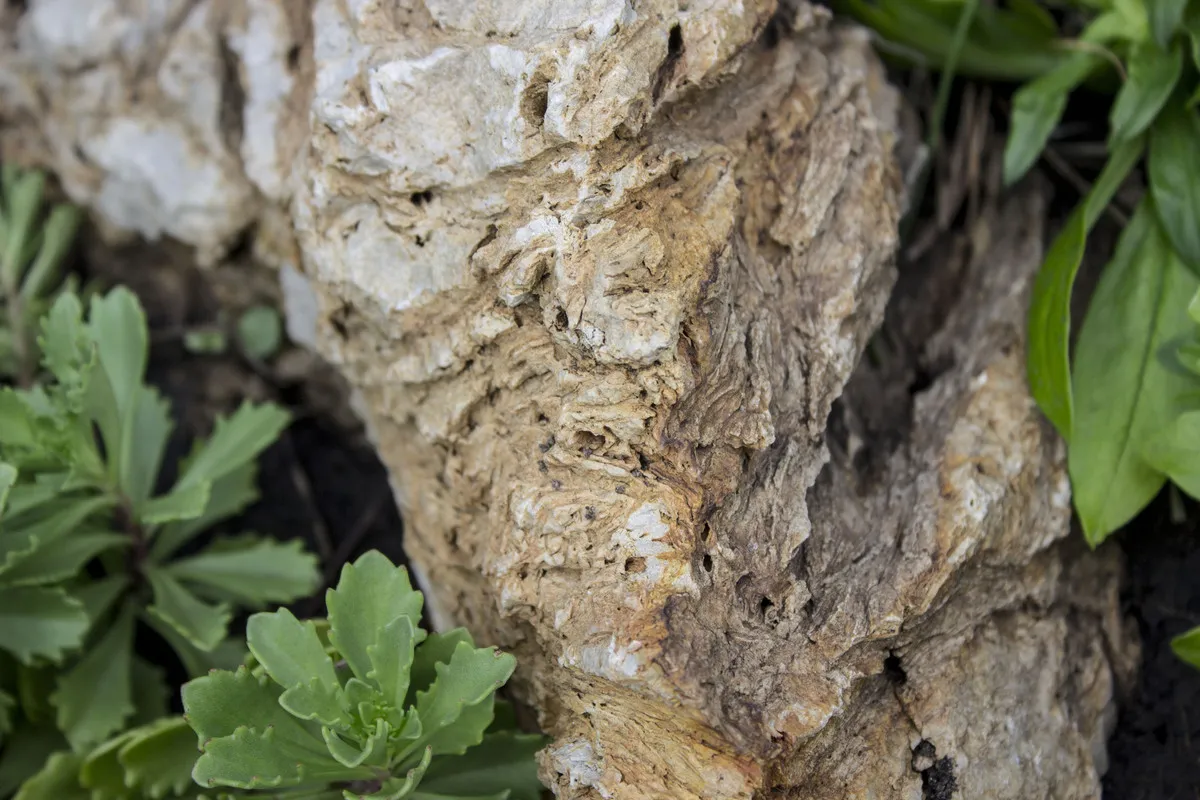My participation in the Contest "Amazing Nature" - June 2021 - №03
@hive-127788/amazing-nature-contest-june-2021-03-open-for-3-weeks-
Observing nature is a very interesting activity. Especially if there is an opportunity to take macro shots. It's a wonderful world of details.

But it is even more amazing when you find in this world something completely special, rare and never seen before. At first you think, "It just can't be!" Not in the sense that this does not exist in nature, but in the understanding that this rarity fell into your hands.

Once I decided to arrange a rockery in my garden. This is such a flower bed with stones and plants. For this, my husband brought several stones. They were all of the usual appearance, except for one.

It was of a special color and all in small holes, as if someone had drilled them. When the next day I told my husband about my find, he did not believe me, because in our area we had met this for the first time.

This is a petrified tree. The process of fossilization itself takes place in special conditions. The tree should be under sedimentary rocks (which is quite natural during the movement of glaciers). When water saturated with minerals flows through this sediment, then in the end these same minerals enter and accumulate in the cells of the plant. After a long time, cellulose and lignin decompose, leaving a fossil that exactly repeats the original shape. As a result of this process, all substances of organic origin are replaced by minerals.

In general, such fossils are not uncommon. There are even geological reserve parks in the world with similar exhibits. I can assume that the yellowish-sandy color of our stone is the result of petrification in the presence of iron or manganese oxide impurities in the soil.

View of the West Siberian Plain from the Altai Spurs *
Now this stone is overgrown with grass and few people see it. But I know his origin and I have a special attitude towards him. This stone is a relic. After all, once on the territory of western Siberia, the Turgai Sea (West Siberian) swayed - a large salty shallow water, it stretched north from the present Caspian Sea and to the borders of the Palearctic. It appeared about 40 thousand years ago, and disappeared during the interglacial period, about 31-32 thousand years ago.
Наблюдение природы очень интересное занятие. Особенно если есть возможность сделать макроснимки. Это удивительный мир подробностей. Но ещё удивительнее когда вы находите в этом мире что-то совершенно особенное, редкое и никогда вами ранее не виданное. Сначала вы думаете: “Этого просто не может быть!”
Не в том смысле, что этого нет в природе. А в понимании того, что эта редкость попала к тебе в руки.
Однажды я решила устроить в своём саду рокарий. Это такая клумба с камнями и растениями. Для этого мой муж привёз несколько камней. Все они были обычного вида, кроме одного. Был он особенного цвета и весь в маленьких дырочках, будто будто кто-то просверлил их . Когда на следующий день я сообщила мужу о своей находке, он мне не поверил, потому что в нашей местности такое мы повстречали впервые.
Это - окаменелое дерево. Сам процесс окаменения происходит в особенных условиях. Дерево должно находиться под осадочными породами (что в период движения ледников вполне естественно). Когда сквозь этот осадок течёт насыщенная минералами вода, то в итоге эти самые минералы попадают и накапливаются в клетках растения. По истечении долгого времени происходит распад целлюлозы и лигнина, остаётся окаменелость, в точности повторяющая исходную форму. В результате этого процесса все вещества органического происхождения замещаются минералами.
Вообще, подобные окаменелости встречаются нередко. В мире есть даже геологические парки-заповедники с подобными экспонатами. Могу предположить, что желтовато-песочный цвет нашего камня - это результат окаменения при наличии в почве примесей оксида железа или марганца.
Теперь этот камень оброс травой и его мало кто видит. Но я знаю его происхождение и отношение у меня к нему особое. Этот камень-реликт. Ведь когда-то на территории западной Сибири колыхалось Тургайское море (Западно-Сибирское) - большое солёное мелководье, оно простиралось к северу от нынешнего Каспийского моря и до границ Палеарктики. Появилось оно примерно около 40 тысяч лет тому назад, а исчезло в период межледниковья, около 31-32 тысяч лет назад.
